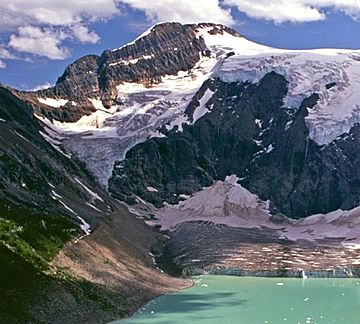Commander Mountain facts for kids
Quick facts for kids Commander Mountain |
|
|---|---|

Commander Mountain, northwest aspect
|
|
| Highest point | |
| Elevation | 3,371 m (11,060 ft) |
| Prominence | 91 m (299 ft) |
| Parent peak | Jumbo Mountain (3437 m) |
| Listing | Mountains of British Columbia |
| Geography | |
| Location | British Columbia, Canada |
| Parent range | Purcell Mountains |
| Topo map | NTS 82K/07 |
| Climbing | |
| First ascent | 1915 |
| Easiest route | North ridge |
Commander Mountain is a huge, icy mountain peak in British Columbia, Canada. It stands 3,371-metre (11,060 ft) tall. This makes it one of the highest mountains in the Purcell Mountains. It's located about 42 km (26 mi) west of a town called Invermere.
The mountain got its name in 1915 from Winthrop E. Stone. He was part of the very first group to climb to the top. The name was officially accepted in 1962.
Where is Commander Mountain?
Commander Mountain is found in the beautiful Purcell Mountains. These mountains are part of the larger Columbia Mountains in southeastern British Columbia. It's the seventh-tallest mountain in the Purcell range.
- The mountain is 2 km (1.2 mi) north of Jumbo Mountain. Jumbo Mountain is even taller!
- Another peak, The Lieutenants, is about 2.12 km (1.32 mi) to the west.
Climbing to the Top
The very first time someone climbed Commander Mountain was on August 4, 1915. A group of climbers reached the summit using the north ridge. This group included A.H. and E.L. MacCarthy, M. and W.E. Stone, B. Shultz, and the famous mountain guide Conrad Kain.
Over the years, other ways to climb the mountain have been found:
- North Ridge: This was the route used for the first climb in 1915. It's rated as a class 2-3 climb, which means it's moderately difficult.
- South Ridge: This route was first climbed in 1928. The team included Kate Gardiner, Byles, and Feuz. It's a bit harder, rated as a class 3 climb.
Weather and Glaciers
Commander Mountain is in a cold, snowy area. This type of climate is called a subarctic climate.
- Winters are very cold with lots of snow.
- Temperatures can drop below −20 °C. With the wind, it can feel even colder, sometimes below −30 °C!
- Summers are mild, not too hot.
This cold weather helps keep two important glaciers on the mountain. A glacier is a huge, slow-moving river of ice.
- The Jumbo Glacier is on the west side of the mountain.
- The Commander Glacier is on the east side.
The water from melting snow and ice on the mountain flows into Horsethief Creek. This creek then joins the big Columbia River.



